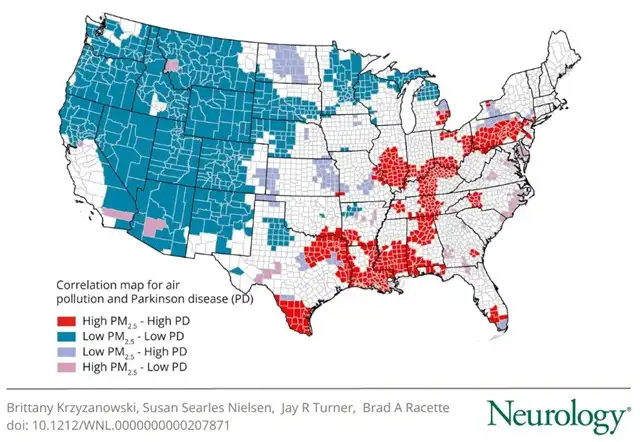Air Pollution May Increase the Risk of Parkinson’s Disease by 56%
- EB Virus Could Be Infected by Kiss: A Hidden Threat Linked to Cancer
- The Silent Threat: How Gas Stoves Pollute Our Homes and Impact Health
- Paternal Microbiome Perturbations Impact Offspring Fitness
- New Report Casts Doubt on Maradona’s Cause of Death and Rocks Manslaughter Case
- Chinese academician unable to provide the exact source of liver transplants
- Early Biomarker for Multiple Sclerosis Development Identified Years in Advance
Breakthrough Study Reveals: Air Pollution May Increase the Risk of Parkinson’s Disease by 56%
- AstraZeneca Admits for the First Time that its COVID Vaccine Has Blood Clot Side Effects
- Was COVID virus leaked from the Chinese WIV lab?
- HIV Cure Research: New Study Links Viral DNA Levels to Spontaneous Control
- FDA has mandated a top-level black box warning for all marketed CAR-T therapies
- Can people with high blood pressure eat peanuts?
- What is the difference between dopamine and dobutamine?
- How long can the patient live after heart stent surgery?
Breakthrough Study Reveals: Air Pollution May Increase the Risk of Parkinson’s Disease by 56%
Researchers have found that people living in areas with moderate levels of air pollution have a 56% increased risk of developing Parkinson’s disease.
The study indicates regional differences in this risk, with the Mississippi-Ohio River Valley being classified as a high-risk area.
This groundbreaking geographical analysis confirms a strong connection between Parkinson’s disease and fine particulate matter, highlighting the need for stricter air quality control to reduce this risk.

A study conducted by researchers from the Barrow Neurological Institute has shown that people living in areas with moderate levels of air pollution have a 56% increased risk of developing Parkinson’s disease compared to those living in areas with the lowest levels of air pollution.
Published recently in the journal “Neurology” by the American Neurological Association, this research aimed to identify a nationwide geographic pattern for Parkinson’s disease and to test the association between fine particulate matter and both nationwide and region-specific cases of the disease.
Dr. Brittany Krzyzanowski, a researcher at the Barrow Neurological Institute, stated, “Previous research has suggested that fine particulate matter can lead to brain inflammation, which is a known mechanism for the development of Parkinson’s disease. Using advanced geographical spatial analysis techniques, we have, for the first time, confirmed a strong connection between the incidence of Parkinson’s disease and fine particulate matter on a national scale in the United States.”
The study also found that the relationship between air pollution and Parkinson’s disease varies across different regions of the United States. Hotspots for Parkinson’s disease were identified in the Mississippi-Ohio River Valley, the central region of North Dakota, parts of Texas, Kansas, the eastern part of Michigan, and a corner of Florida. People living in the western half of the United States had a lower risk of developing Parkinson’s disease compared to other regions.
“The regional differences in Parkinson’s disease may reflect regional variations in the composition of particulate matter. Some regions may have more toxic components in their particulate matter compared to others,” Krzyzanowski explained.
Although the study did not investigate the specific sources of air pollution, Krzyzanowski pointed out that the Mississippi-Ohio River Valley has a relatively high density of road networks and is also part of the Rust Belt. This suggests that pollution in these areas may contain more combustion particles from traffic and heavy metals from manufacturing, which are related to cell death in brain regions associated with Parkinson’s disease.
Research Methods and Implications
This population-based geographical study identified nearly 90,000 Parkinson’s disease patients from a dataset of approximately 22 million medical insurance records. Individuals confirmed to have Parkinson’s disease were geocoded based on their place of residence, allowing researchers to calculate the incidence of Parkinson’s disease in each area. The researchers also calculated the annual average concentrations of fine particulate matter in these specific regions. After adjusting for other risk factors, including age, gender, race, smoking history, and healthcare utilization, the researchers at the Barrow Neurological Institute were able to determine the association between a person’s previous exposure to fine particulate matter and their subsequent risk of developing Parkinson’s disease.
Krzyzanowski stated, “Population-based geographical studies like this have the potential to uncover the crucial role of environmental toxins in the development and progression of Parkinson’s disease, and similar methods can be used to explore the health outcomes of other neurological systems.”
Researchers hope that the data from this innovative study will contribute to the implementation of stricter policies to reduce air pollution levels and lower the risk of developing Parkinson’s disease and other related conditions.
Krzyzanowski concluded, “While efforts have been made for years to study environmental risk factors for Parkinson’s disease, most of the work has been focused on pesticide exposure. This study suggests that we should also consider air pollution as a contributing factor to the development of Parkinson’s disease.”
Breakthrough Study Reveals: Air Pollution May Increase the Risk of Parkinson’s Disease by 56%
(source:internet, reference only)
Disclaimer of medicaltrend.org
Important Note: The information provided is for informational purposes only and should not be considered as medical advice.



